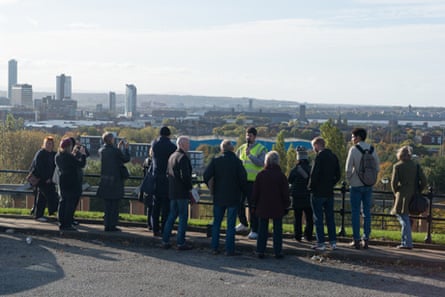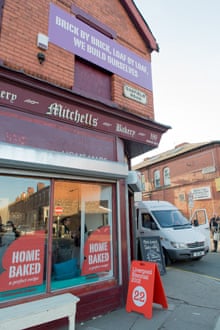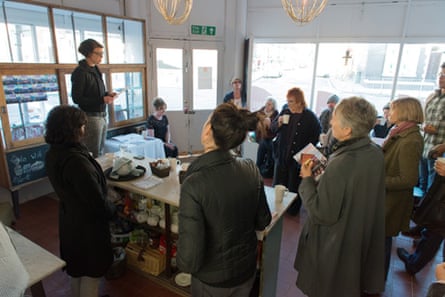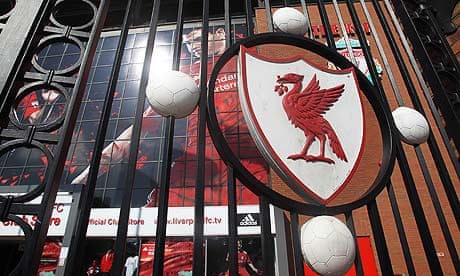It's rather surreal to be taken on a tour of a city you live in, but then this is quite a different tour. We start conventionally enough, by the Edwardian splendor of the Cunard building at the heart of Liverpool's regenerated waterfront, but soon we will be heading to the other side of the city – and the other side of Britain.
After we pile into the minibus, our tour guide Carl Ainsworth announces that we're heading for a district in the north of the city, Anfield. The word for many means solely the home ground of Liverpool FC, but Anfield is also one of the city's oldest residential districts.
Welcome to the Anfield Home Tour, part of the Liverpool Biennial, the UK's largest visual arts festival. The arts in Liverpool have always had something of a social conscience, and the Biennial is no exception; we are not heading to Anfield to look at football stadia or recently restored Stanley Park, but to learn about housing, community and regeneration.

Our first stop is Everton Park, where Carl tells us a story that sums up the British urban landscape in microcosm. From the top of the hill above the Mersey, there are amazing views across central Liverpool as far as the mountains of Wales on a good day. It was this view which led rich merchants to build fine houses here in the 18th century, some of which remain. With the expansion of nearby docks and industry, however, speculators built hundreds of densely packed terraced houses in the area, described by Carl as a "tidal wave".
The merchants then moved further out, and a tight-knit working class community was formed on streets so steep that is some cases they had railings to help people climb them. Then, from the 1930s onwards, there were successive 'slum clearance' programmes, culminating in mass demolition in the 1960s. Many people were moved to overspill estates and new towns on the edge of the city. Others meanwhile lived out Le Corbusier's vision of 'a machine for living in' at huge new high-rise blocks of flats. Some enjoyed scaling these new heights, and those old 'tight-knit' streets also often meant horrible conditions, but the dream soon turned sour. Carl reveals that some of these 'new visions' in housing were demolished fewer than ten years after being built.
In the 1980s, from the rubble of tower blocks came Everton Park , a green space on wasteland; but one with little thought given to its integration into the local area. Carl says:
Many former residents of the area come here to have picnics right where their houses used to be. You'd think from all that history, the powers that be would have learned.
We find that they did not. Anfield was one of many areas in the UK subject to the Housing Market Renewal Initiative (HMRI). Despite the housing boom from the 1990s onwards, there were areas of the UK that stagnated, mostly in the north of England. The then government took up a report from Birmingham University's Centre for Urban and Regional Studies. They decided what was needed was demolition, en masse, and new built homes, en masse. The process became the HMRI.

We arrive in Anfield to an area of new homes built by Keepmoat Construction. There's been criticism from some that such houses in HMRI areas aren't as 'nice and neat' as the terraces they replaced. However, as Carl points out, they do have gardens, off-street parking and modern levels of insulation and damp proofing, things denied to many though not all of the old houses. The tragedy of these homes, though, is that many people who owned the demolished homes did not get a good enough price for them under compulsory purchase orders to buy one of the new ones. They often had to take out second mortgagees in old age to be able to buy somewhere to live.
New homes in a community are all very well, but not if the community has to get into debt to buy them when they owned their old homes outright. With the cancellation of HMRI by the present government, we are told it was even touch and go if these new homes would be built or just wasteland left in their place.
As Carl points out, the biggest problem with HMRI was in its title: market renewal, not community or neighborhood renewal. This was of course, pre-crunch, when the market appeared to have the answer to everything; it just needed to be helped on its way. Speaking of markets, in my favourite part of the tour Carl passes two bricks around the bus, one from the new building site and one from the demolished homes. The new brick we are told is worth 30p, the old brick £1. Apparently bricks from the demolished homes are being exported to building sites around the UK, even abroad. Carl tells us:
There's about 20,000 bricks in an average terrace, whole streets demolished, you do the math.
As we drive down Granton Road, one of the 'tinned up' streets awaiting demolition, Carl plays a recording by Jayne Lawless, a former resident, recalling how just a few years ago, every house in the street was occupied. She speaks of the "controlled decline" under HMRI, which saw people pushed to leave, one by one, until the last residents left in despair. She says:
They said we were deprived, don't remember being deprived.
However, Anfield isn't all dereliction, although newspapers have been full of emotive photos of empty homes. That is one reality, but just round the corner is another. Skerries Road is a traditional terraced street renovated to looking almost new by residents who refused to move. It shows how a different approach can succeed.
Then another local resident, Bob, gets on the bus as we drive past the house where he lived for 50 years. Now it sits empty, with abandoned properties all around. Yet this wasn't a HMRI street. When former council houses were sold under 'right to buy', many ended up owned by landlords who rented to whoever they could get. Bob says this saw an increase of "unruly families" moving in, and with them anti-social behavior, crime and then often abandonment. Bob is a regular on Liverpool's pub singing scene and gives us a rendition of 'This Old House' by Rosemary Clooney, before we move on.

We finish the tour at the former Mitchell's Bakery, a local business for over 100 years which closed in 2010 and has now become a community hub, the centre of a two-year plan worked up between artist Jeanne van Heeswijk, on a Liverpool Biennial commission, and a myriad of other participants and project partners.
When they began, they had no idea where the idea would lead. The answer is a long-term plan to re-open the bakery as a cooperative, offering local people jobs and training and a Community Land Trust (CLT). If the city council lifts the current clearance order on the building, the CLT hopes to buy it and refurbish the bakery's former living accommodation. Architect Marianne Heaslip and a group of local young people have drawn up the plans. In the long run the CLT would like to take on more buildings in the area and renovate them for not for profit re-occupation. The bakery has now been refurbished internally and with community members undergoing training, they hope to start trading soon.
Then, a surprise: over tea and cakes, Carl reveals that he is actually actor Graham Hicks, but that all the stories we have heard are true. Britt Jurgensen, who directed the tour and co-wrote its script with Graham and local novelist Debbie Morgan, adds that many in the community were reluctant to get involved with this project. They had been let down so much by outsiders in the past. But this external spark brought them together, relieved the frustration of waiting for others to make decisions for them and has acted as a new impetus for residents to become stakeholders in their neighbourhood.
"This is our future," says Britt, a theatre professional who lives locally and is a member of the CLT and the bakery cooperative. Progress will be slow but from the ground up, not a grand vision imposed from outside. The catalyst may have been the Liverpool Biennial, but local people are now taking things far beyond the ideas of any curators or artists. She says:
I hope we will be able to sustain ourselves as a group and know when to pass responsibilities on to new people. I hope we will be courageous enough to admit when we make mistakes and adapt our plans when it is appropriate. And I hope we will continue to enjoy ourselves whilst we do all that.
As we munch cake, there is much discussion within our tour group, many of whom have never met before, about the injustice, the problems, and the potential solutions for Anfield and elsewhere. Overall, the feeling is one of energy, of something good coming out of a mess and of things finally, slowly, heading in the right direction.

In the hierarchy of needs in austere times in deprived areas, art may come pretty low, but if art can help regain food and shelter, pride and spirit, then it has a purpose both practical and ephemeral. This was a story that could have been complex, technical, dull and aggressively ideological; instead it has been brilliantly reduced to its actual simplicity: what has been done to a community, and what needs to be done to repair the damage. Its message is simple, and one we should all have learned long ago: The people who know what is best for communities are communities themselves and they are the only people who can truly regenerate an area.
The Liverpool Biennial has often struggled to define itself apart from all the other art festivals in the world. Given Liverpool's weather, it isn't necessarily going to attract the crowds that head to Venice, Lisbon or Miami. With more projects like this though, it can express itself as something unique in the world.
The success of the Eldonian Village, a self-organised community that began in Liverpool in an area of urban blight in the 1980s, just a mile or so from Anfield, is testament to what can be achieved if the support and will is there. Anfield clearly has the will. It remains to be seen though, if those powers that be, whatever coloured rosette they happen to wear, will give them the power and the financial resources to build on this creative start.
Kenn Taylor is a writer and journalist based in Liverpool. You can follow him here and here. Photographs by Mark Loudon. You can read more about the bakery project here.

Comments (…)
Sign in or create your Guardian account to join the discussion